Native Plants for The Valley of the Sun
 Looking to add native plants to your desert garden and landscape? We've got a variety of flowers, trees and shrubs that are native to Arizona—many of which attract and support beneficial pollinators.
Looking to add native plants to your desert garden and landscape? We've got a variety of flowers, trees and shrubs that are native to Arizona—many of which attract and support beneficial pollinators.
Pollinator-Attracting Native Plants
These plants not only add beauty and diversity to gardens and landscapes but also play a vital role in supporting local pollinator populations. By choosing to include pollinator-friendly plants in your garden, you're contributing to the health and sustainability of your local ecosystem.
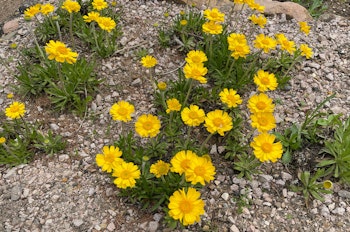
Angelita Daisy (Tetraneuris acaulis)
- Compact, perennial herb with bright yellow daisy-like flowers that attract bees and butterflies.
- Its continuous blooming cycle provides a reliable source of nectar throughout the year.
- Blooms nearly year-round in warm climates.
- Thrives in full sun and well-drained soils.
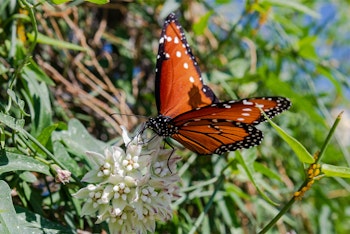
Arizona Milkweed (Asclepias angustifolia)
- Perennial with narrow leaves and clusters of small, white to pinkish flowers.
- Important host plant for monarch butterfly larvae.
- Prefers sandy, well-drained soils and partial shade to full sun.
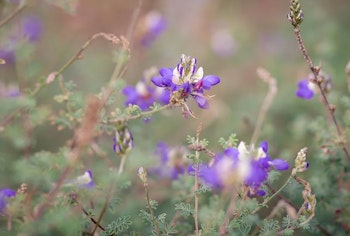
Black Dalea (Dalea frutescens)
- Small, woody shrub with purple to blue flowers.
- Blooms in the fall and winter.
- Drought-tolerant and thrives in full sun.
Photo courtesy of Civano Growers.
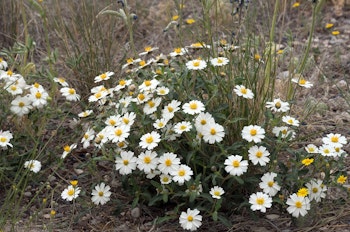
Blackfoot Daisy (Melampodium leucanthum)
- Low-growing, mounding perennial with white daisy-like flowers and yellow centers.
- Blooms from early spring to fall.
- Prefers full sun and well-drained soils; drought-tolerant.
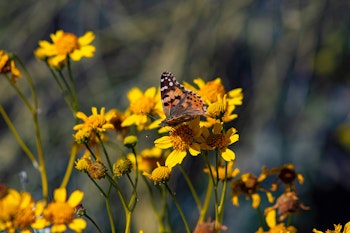
Brittle Bush (Encelia farinosa)
- Medium-sized shrub with silver-gray foliage and yellow, daisy-like flowers.
- Flowers in late winter to spring.
- Drought-tolerant; thrives in full sun and requires well-drained soils.
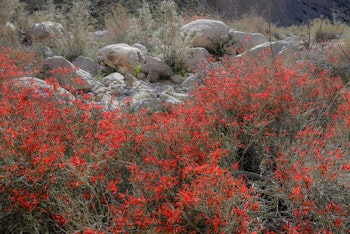
Chuparosa (Justicia californica)
- Shrub with tubular red or orange flowers, that are a favorite of hummingbirds.
- Chuparosa is an important nectar source for these birds, especially in the late winter and spring when it is in bloom and other food sources may be scarce.
- Prefers full sun to partial shade and is drought-tolerant.
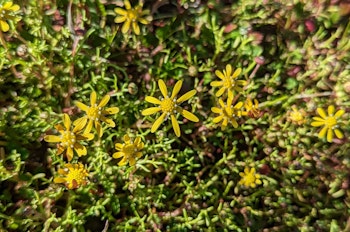
Damianita Daisy (Chrysactinia mexicana)
- Low-growing, evergreen shrub with bright yellow, daisy-like flowers.
- Blooms in spring and fall.
- Prefers full sun and well-drained soils; drought-tolerant.
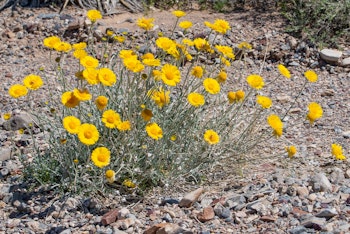
Desert Marigold (Baileya multiradiata)
- A SummerWinds favorite, this perennial or biennial with large, bright yellow daisy-like flowers attract bees and butterflies.
- Its long blooming season ensures that pollinators have access to its resources for much of the year.
- Blooms from spring to fall.
- Drought-tolerant; thrives in full sun and well-drained soils.
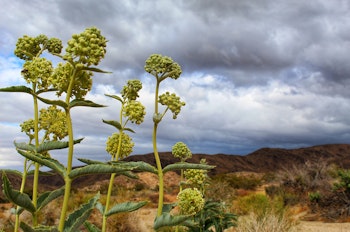
Desert Milkweed (Asclepias subulata)
- A SummerWinds favorite, this tall, stemmy plant boasts clusters of small, white flowers.
- Important for monarch and queen butterflies.
- Prefers full sun and well-drained, sandy soils.
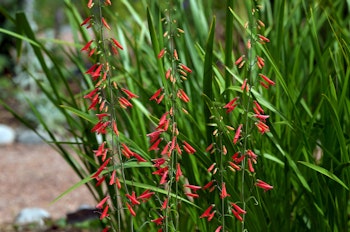
Firecracker Pentemon (Penstemon eatonii)
- Perennial with bright red, tubular flowers on tall spikes, attractive to hummingbirds.
- Provides an excellent source of nectar in late winter to early spring.
- Blooms in late winter to early spring.
- Prefers full sun to light shade and well-drained soils.
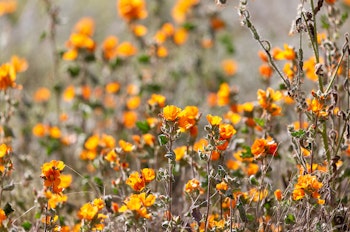
Globe Mallow (Sphaeralcea ambigua)
- Perennial shrub with cup-shaped flowers in shades of orange, pink, or red attract bees and butterflies.
- Globe Mallow is a host plant for several types of butterflies, providing both nectar and larval food.
- Blooms in spring and intermittently into fall.
- Drought-tolerant; thrives in full sun and tolerates poor, dry soils.
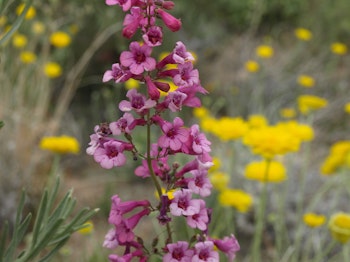
Parry's Penstemon (Penstemon parryi)
- Tall spikes of bright pink to purple flowers that are magnets for hummingbirds and bees in the early spring, providing an important nectar source during this time.
- Prefers full sun and well-drained soils; drought-tolerant.
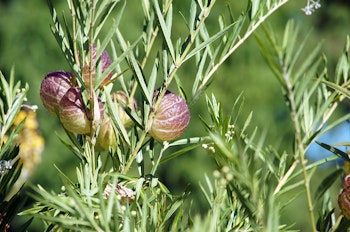
Pineleaf Milkweed or Pine Needle Milkweed? (Asclepias linaria)
- Perennial with narrow, pine-like leaves and clusters of small, white flowers.
- Important for monarch butterfly larvae.
- Prefers full sun and well-drained soils.

Pink Fairy Duster (Calliandra eriophylla)
- Small, bushy shrub with delicate, pink, puffball-like flowers.
- Blooms in early spring and sporadically throughout the year.
- Prefers full sun to partial shade and well-drained soils; drought-tolerant.
Each of these plants offers unique benefits for landscaping in Arizona, providing beauty, habitat for wildlife, and drought tolerance.
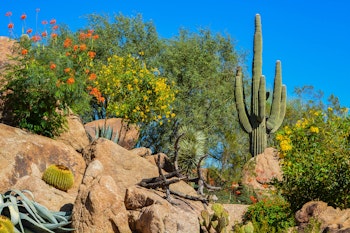 Other Native Shrubs
Other Native Shrubs
Native shrubs are an excellent addition to desert gardens and landscapes for several reasons. Firstly, they are inherently adapted to the harsh conditions of desert environments, including extreme temperatures, limited rainfall, and poor soil quality. This means they require significantly less water and maintenance than non-native species, making them both environmentally sustainable and cost-effective.
Additionally, native shrubs provide essential habitat and food sources for local wildlife, including pollinators like bees, butterflies, and hummingbirds, as well as birds and small mammals. Their natural resilience also contributes to soil stabilization and erosion control, further supporting the ecosystem's health
By incorporating native shrubs into your garden or landscape, you're not only creating a beautiful, low-maintenance space but also contributing to the biodiversity and ecological balance of your local environment.
Whether you're aiming for a vibrant display of flowers, a haven for wildlife, or simply a serene and sustainable outdoor area, native shrubs offer a variety of textures, colors, and forms to meet your landscaping goals.
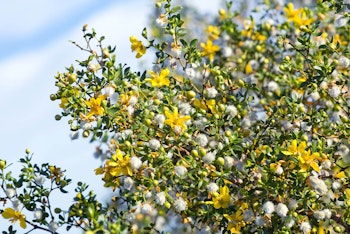
Creosote Bush (Larrea tridentata)
- Evergreen shrub with small, waxy green leaves and yellow flowers.
- Known for its distinctive creosote scent after rain.
- Extremely drought-tolerant, thrives in full sun and well-drained soils.

Desert Broom (Baccharis sarothroides)
- Fast-growing, evergreen shrub with slender, green stems and tiny white flowers.
- Thrives in full sun and tolerates a range of soil types, including disturbed areas.
- Often used for erosion control.
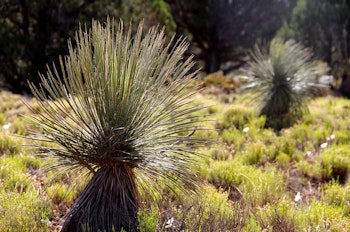
Desert Spoon (Dasylirion wheeleri)
- Slow-growing succulent with a rosette of long, slender, gray-green leaves edged with sharp teeth.
- Tall flower spike with small, white flowers appears in summer.
- Prefers full sun and well-drained soils; drought-tolerant.
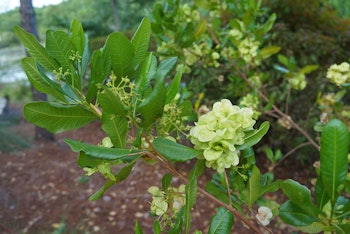
Hopseed Bush (Dodonaea viscosa)
- A SummerWinds favorite, this evergreen shrub has attractive, lance-shaped leaves and papery, hop-like seed pods.
- Can be used as a screen or hedge.
- Tolerates a variety of soil types and conditions, prefers full sun to partial shade.
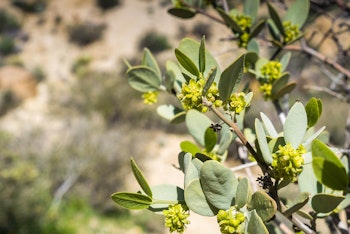
Jojoba (Simmondsia chinensis)
- A SummerWinds favorite, this dense, slow-growing shrub has leathery leaves and small, greenish-yellow flowers.
- Produces a nut that contains an oil similar to whale oil.
- Drought-tolerant; thrives in well-drained soils and full to partial sun.
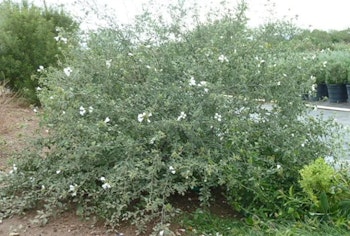
Little Leaf Cordia (Cordia parvifolia)
- Small, evergreen shrub with white, bell-shaped flowers and dark green, leathery leaves.
- Flowers bloom in spring and summer.
- Prefers full sun and well-drained soils; drought-tolerant.
Photo courtesy of Civano Growers.
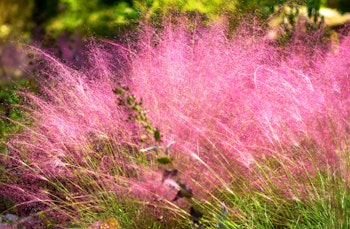
Muhly Grass (Muhlenbergia spp.)
- Ornamental grass known for its fine-textured foliage and spectacular fluffy, cloud-like seed heads in fall.
- Varieties can vary in color from pink to purple.
- Prefers full sun and well-drained soils; drought-tolerant.
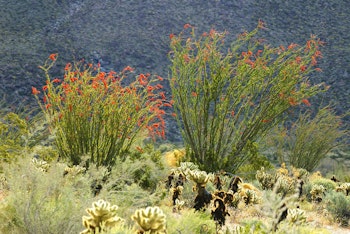
Ocotillo (Fouquieria splendens)
- Tall, spiny, cactus-like shrub with long, cane-like stems that burst into bright red flowers at the tips in spring.
- Leaf out after rain.
- Prefers full sun and well-drained soils; extremely drought-tolerant.

Rosewood (Vauquelinia californica)
- Evergreen shrub or small tree with glossy, dark green leaves and clusters of white flowers.
- Blooms in spring.
- Drought-tolerant once established; prefers full sun and well-drained soils.
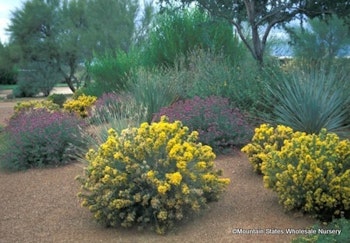
Turpentine Bush (Ericameria laricifolia)
- Small, evergreen shrub with needle-like leaves and bright yellow, daisy-like flowers.
- Blooms in late summer to fall.
- Prefers full sun and well-drained soils; highly drought-tolerant.
These plants are well-suited for Arizona's climate and can provide varied textures, colors, and forms to a landscape, while also being adaptable to the arid conditions.
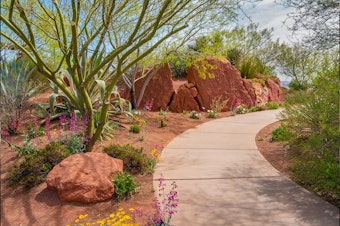 Native Trees
Native Trees
Native trees are ideal for desert landscapes due to their adaptability to harsh conditions, requiring less water and maintenance, thus promoting sustainability. They support local ecosystems by providing habitats and food for wildlife, enhancing soil stability, and contributing to biodiversity. With a variety of shapes, sizes, and colors, native trees offer versatile design options, enriching the aesthetic and ecological value of gardens. Planting native trees aligns with eco-friendly practices, fostering a resilient and vibrant outdoor space that conserves resources while supporting the natural environment—plus, they can add some much appreciated shade to your desert landscape!

Desert Willow (Chilopsis linearis)
- Deciduous tree with narrow, willow-like leaves and showy, fragrant, orchid-like flowers ranging from pink to lavender.
- Attracts bees, butterflies, and hummingbirds throughout its blooming season, offering abundant nectar.
- Blooms in late spring to early fall.
- Thrives in full sun and well-drained soils; drought-tolerant once established. Attracts hummingbirds and bees.
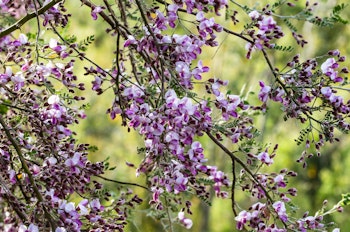
Ironwood (Olneya tesota)
- Evergreen tree known for its dense, hard wood and gray-green foliage. Produces small, purple flowers in late spring.
- Extremely slow-growing and long-lived.
- Prefers full sun and well-drained soils; extremely drought-tolerant. Provides habitat and food for wildlife.
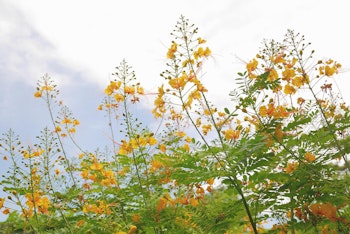
Mexican Bird of Paradise (Caesalpinia mexicana)
- Evergreen shrub or small tree with bright green, fern-like foliage and showy clusters of yellow flowers that bloom throughout the warmer months.
- Attracts a variety of pollinators, including bees and butterflies, making it a vibrant addition to any garden seeking to support pollinator populations.
- Fast-growing and can be pruned to maintain desired shape.
- Prefers full sun and well-drained soils; drought-tolerant. Attracts birds and butterflies.
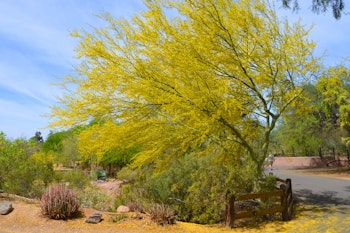
Palo Verde (Parkinsonia spp.)
- A SummerWinds favorite, this deciduous tree known for its green bark and branches, which photosynthesize. Produces vibrant yellow flowers in spring.
- Fast-growing and can provide quick shade. Several species, including the Blue Palo Verde (Parkinsonia florida) and the Foothills Palo Verde (Parkinsonia microphylla).
- Thrives in full sun and well-drained soils; highly drought-tolerant. Important habitat for birds and other wildlife.
Each of these plants adds unique beauty and ecological value to landscapes in Arizona and the Southwestern United States, adapting well to the arid conditions and often providing critical support for local wildlife.
For native plants that support our threatened desert tortoise, click here.

